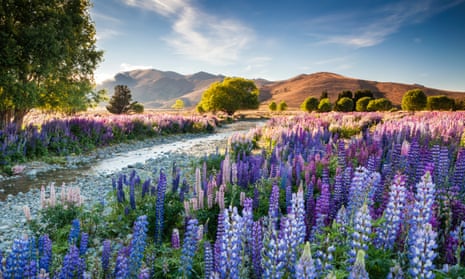This is the winner of the International Garden Photographer of the Year competition. It was entered under the wildflower landscapes category and there is no doubt that it is an incredible photograph.
The judges quite rightly praised it highly:
This picture is totally immersive and a joy to behold. The eye is led to the horizon by the diagonals of the stream and the trees ... making this an elegant symphony of plants and nature.
Everything about the picture is perfect. I want to step into it and live out the rest of my days in the bliss of that dream.
Or is it a nightmare?
The photographer Richard Bloom did not cover up the fly in the ointment of the picture when he said: “On the way to Lake Tekapo on the South Island of New Zealand in early summer the landscape, already amazing, was scattered with drifts of naturalised lupins”. There it is: the word naturalised. The lupins that look so beautiful are actually a non-native, invasive species. In New Zealand where the picture was taken their detrimental impact is huge.
The Russell lupin, Lupinus polyphyllus, hailing from North America, and used in a hybridisation program that subsequently gave it increased vigour, is such a mild-mannered and quintessential cottage garden plant here in the UK and a complete thug in New Zealand. Colonising streambanks, just like in the picture, they are taking over a habitat so important for New Zealand’s unique wildlife. Riverbed birds such as wrybill, black stilt and banded dotterel are being pushed out of their natural home by a garden plant introduced to New Zealand.
Of course we all know and understand the ill effects of the introduction of plants such as Japanese knotweed and Himalayan balsam to the UK. The thought of such plants puts fear into the minds of ecologists, local councils and homeowners alike. However, with more non-native species of plants here in the UK than those that are truly native, should they all really be tarred with the same brush? Many of these invaders form an important part of the ecosystem, don’t they?
In the UK, some of our most iconic plant species are originally, non-native; snowdrops, red deadnettle, green hellebore and white campion are among them. Would our meadows be quite so rich without snakeshead fritillaries or our corn fields so iconic without red poppies? With the onslaught of climate change ahead, are we not likely to see more species spreading to the UK and making this their home? Species such as the small flowered tongue orchid (Serapias parviflora) may eventually become more common, finding its way here from its more usual Mediterranean home either by natural or human means.
Certainly in New Zealand the lupins bring tourists from all around to Lake Tekapo and command a not insignificant income for the region. They are also a food source for the long tailed blue butterfly (Lampides boeticus) - a recent colonist of New Zealand too, which found itself there without the aid of humans. In fact, new species are finding their way to our shores, and those of other countries, all of the time by means both natural and artificial.
But who knew that plants like Chilean rhubarb (Gunnera tinctoria) would end up on the invasive species list, and have their sale controlled, other than the gardeners watching as they saw the plants spread down the stream that ran through the garden? Who really understood that a plant bred in France from two South African species would end up on schedule 9 of the Wildlife and Countryside Act, 1981, other than the gardener that couldn’t bear the orange glare of the montbretia (Crocosmia x crocosmiiflora) that had taken over their garden any longer and fly-tipped it into a Cornish hedgerow? As gardeners, we relish the idea of a new and exciting plant for our gardens, but we are quick to throw such a plant out when it starts to take over.
In a world that is changing faster than some species are able to keep up with, we need to be vigilant by judging each and every species on its own merits or failures. Gardeners are those most often moving these plants around the globe, so the onus is on us to be aware. We should minimise the risks where we can, and see the potential of what could turn out to be the next knotweed, balsam, montbretia or lupin. We need to work within the laws and guidelines of our country, put there for good reason, and pay heed to the warnings of those organisations that understand. We should, however, also be aware that new species can enrich our gardens, landscape and the biodiversity within them as these new and often interesting colonisers are certainly not always bad.
Are those lupins in the photograph ‘wildflowers’? Was it right to allow a photograph of a non-native, invasive species win such a competition? Were the judges fully aware of the issues surrounding the plants they were looking at? I don’t know. What I do know though is that the photograph, as a piece of art, did its job. It made me react and left me questioning it and the world it depicted – It made me look deeper at the garden that is our planet and affirmed the importance of gardeners to it.
